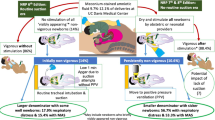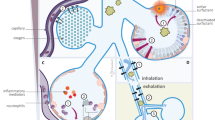Abstract
Objective:
The purpose of this study was to evaluate the demographic and treatment characteristics of neonates (⩾37 weeks' estimated gestational age) who were admitted to a neonatal intensive care unit (NICU) for a diagnosis of meconium aspiration syndrome (MAS) during the years 1997 to 2007. The goals in studying this group of neonates were to better estimate the magnitude of abnormal outcomes and to determine the proportion of these infants exposed to specific therapeutic interventions.
Study Design:
Retrospective review of an administrative de-identified data set.
Result:
A total of 415 772 neonates formed the starting data set and 162 075 (39%) were ⩾37 weeks. Of the 162 075 term neonates, 7518 (1.8% of all neonates and 4.6% of term NICU admissions) had an admission diagnosis of MAS. In the 7518 neonates, the following outcomes were observed: 6124 (81.5%) were discharged home; 679 (9%) were acutely transferred to a higher level of intensive care; 416 (5.5%) were transferred to another clinical service within the hospital; 178 (2.4%) were transferred to another NICU for convalescent care and 88 (1.2%) died. There were 33 (0.4%) who did not have data on outcome at discharge. During the period between 2002 and 2005, acute transfer rates decreased (12.4 to 9%) and the reported rate for death remained relatively constant between 0.9 and 1.5%. There were 107 (1.4%) neonates who were treated (n=61) with, or transferred, for extracorporeal membrane oxygenation (ECMO) (n=46). Three of the sixty-one neonates (4.9%) who were treated with ECMO died.
Conclusion:
Term neonates who are admitted with a diagnosis of MAS continue to represent a high-risk population with significant morbidity, and they often require intensive therapies.
This is a preview of subscription content, access via your institution
Access options
Subscribe to this journal
Receive 12 print issues and online access
$259.00 per year
only $21.58 per issue
Buy this article
- Purchase on Springer Link
- Instant access to full article PDF
Prices may be subject to local taxes which are calculated during checkout


Similar content being viewed by others
References
Wiswell TE, Knight GR, Finer NN, Donn SM, Desai H, Walsh WF et al. A multicenter, randomized, controlled trial comparing Surfaxin (Lucinactant) lavage with standard care for treatment of meconium aspiration syndrome. Pediatrics 2002; 109: 1081–1087.
Gouyon JB, Ribakovsky C, Ferdynus C, Quantin C, Sagot P, Gouyon B . Severe respiratory disorders in term neonates. Paediatr Perinat Epidemiol 2008; 22: 22–30.
Djemal N, Ben AH, Masmoudi K, Rguaieg R, Trigui L, Ben HA et al. Pulmonary function in children after neonatal meconium aspiration syndrome. Arch Pediatr 2008; 15 (2): 105–110.
Vohr BR, Wright LL, Dusick AM, Perritt R, Poole WK, Tyson JE et al. Center differences and outcomes of extremely low birth weight infants. Pediatrics 2004; 113: 781–789.
Horbar JD, Badger GJ, Carpenter JH, Fanaroff AA, Kilpatrick S, LaCorte M et al. Trends in mortality and morbidity for very low birth weight infants, 1991–1999. Pediatrics 2002; 110: 143–151.
Hack M, Wilson-Costello D, Friedman H, Taylor GH, Schluchter M, Fanaroff AA . Neurodevelopment and predictors of outcomes of children with birth weights of less than 1000 g: 1992–1995. Arch Pediatr Adolesc Med 2000; 154: 725–731.
Vohr BR, Wright LL, Dusick AM, Mele L, Verter J, Steichen JJ et al. Neurodevelopmental and functional outcomes of extremely low birth weight infants in the National Institute of Child Health and Human Development Neonatal Research Network, 1993–1994. Pediatrics 2000; 105: 1216–1226.
Bennett CC, Johnson A, Field DJ . A comparison of clinical variables that predict adverse outcome in term infants with severe respiratory failure randomised to a policy of extracorporeal membrane oxygenation or to conventional neonatal intensive care. J Perinat Med 2002; 30: 225–230.
Clark RH, Huckaby JL, Kueser TJ, Walker MW, Southgate WM, Perez JA et al. Low-dose nitric oxide therapy for persistent pulmonary hypertension: 1-year follow-up. J Perinatol 2003; 23: 300–303.
Escobar GJ, Clark RH, Greene JD . Short-term outcomes of infants born at 35 and 36 weeks gestation: we need to ask more questions. Semin Perinatol 2006; 30: 28–33.
Clark RH . The epidemiology of respiratory failure in neonates born at an estimated gestational age of 34 weeks or more. J Perinatol 2005; 25: 251–257.
UK Collaborative ECMO Trail Group. The collaborative UK ECMO (Extracorporeal Membrane Oxygenation) trial: follow-up to 1 year of age. Pediatrics 1998; 101: E1.
Angus DC, Linde-Zwirble WT, Clermont G, Griffin MF, Clark RH . Epidemiology of neonatal respiratory failure in the United States: projections from California and New York. Am J Respir Crit Care Med 2001; 164: 1154–1160.
Finer NN, Barrington KJ . Nitric oxide for respiratory failure in infants born at or near term. Cochrane Database Syst Rev 2006; 18 (4): CD000399. Review. PMID: 17054129
Cleary GM, Wiswell TE . Meconium-stained amniotic fluid and the meconium aspiration syndrome An update Pediatr Clin North Am 1998; 45: 511–529.
Abrams ME, Meredith KS, Kinnard P, Clark RH . Hydrops fetalis: a retrospective review of cases reported to a large national database and identification of risk factors associated with death. Pediatrics 2007; 120: 84–89.
Cohen-Wolkowiez M, Smith PB, Mangum B, Steinbach WJ, Alexander BD, Cotten CM et al. Neonatal Candida meningitis: significance of cerebrospinal fluid parameters and blood cultures. J Perinatol 2007; 27: 97–100.
Laughon M, Bose C, Clark R . Treatment strategies to prevent or close a patent ductus arteriosus in preterm infants and outcomes. J Perinatol 2007; 27: 164–170.
Roy BJ, Rycus P, Conrad SA, Clark RH . The changing demographics of neonatal extracorporeal membrane oxygenation patients reported to the Extracorporeal Life Support Organization (ELSO) Registry. Pediatrics 2000; 106: 1334–1338.
Boedy RF, Howell CG, Kanto WP . Hidden mortality rate associated with extracorporeal membrane oxygenation. J Pediatr 1990; 117: 462–464.
Clark RH, Bloom BT, Spitzer AR, Gerstmann DR . Empiric use of ampicillin and cefotaxime, compared with ampicillin and gentamicin, for neonates at risk for sepsis is associated with an increased risk of neonatal death. Pediatrics 2006; 117: 67–74.
Author information
Authors and Affiliations
Corresponding author
Rights and permissions
About this article
Cite this article
Singh, B., Clark, R., Powers, R. et al. Meconium aspiration syndrome remains a significant problem in the NICU: outcomes and treatment patterns in term neonates admitted for intensive care during a ten-year period. J Perinatol 29, 497–503 (2009). https://doi.org/10.1038/jp.2008.241
Received:
Revised:
Accepted:
Published:
Issue Date:
DOI: https://doi.org/10.1038/jp.2008.241
This article is cited by
-
Meconium aspiration syndrome: a comprehensive review
Journal of Perinatology (2023)
-
Neonatal outcomes of non-vigorous neonates with meconium-stained amniotic fluid before and after change in tracheal suctioning recommendation
Journal of Perinatology (2022)
-
Time needed to intubate and suction a manikin prior to instituting positive pressure ventilation: a simulation trial
European Journal of Pediatrics (2021)
-
Can nasal continuous positive airway pressure be used as primary respiratory support for infants with meconium aspiration syndrome?
Journal of Perinatology (2019)
-
Meconium aspiration syndrome requiring ECMO in newborns with gastroschisis: incidence and surgical outcomes
Pediatric Surgery International (2019)



